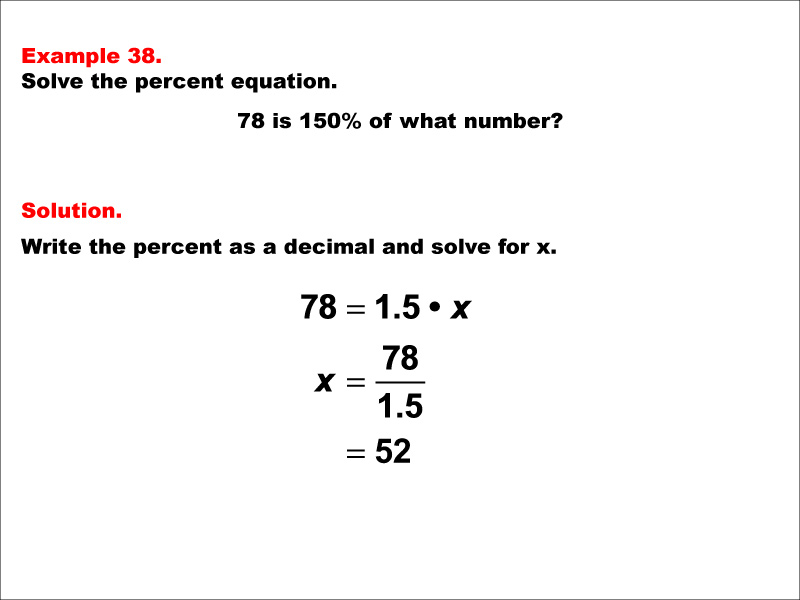
Display Title
Math Example--Percents--Equations with Percents: Example 38
Display Title
Math Example--Percents--Equations with Percents: Example 38

Topic
Solving Equations
Description
This math example focuses on solving percent equations by asking "78 is 150% of what number?" The solution involves setting up the equation 78 = 1.5 * x, then solving for x to get x = 78 / 1.5, which equals 52. This example demonstrates how to calculate the original value when given a percentage greater than 100%, resulting in a number that is smaller than the given value.
Solving equations with percents is a critical skill in mathematics that finds applications in various fields such as finance, statistics, and data analysis. These examples help students grasp the fundamental concept of relating a value to its original amount through percentages, especially when dealing with increases above 100%. This understanding forms the basis for more complex mathematical operations and real-world problem-solving scenarios, such as calculating original prices from marked-up prices, determining initial investments from current values after growth, or understanding scale in various contexts where values can exceed 100%.
Providing multiple worked-out examples is essential for students to fully comprehend this concept. Each new example reinforces the process while introducing different scenarios and number relationships. This approach allows students to recognize patterns, adapt their problem-solving strategies, and build confidence in handling diverse percentage-based calculations. By practicing with various value pairs, including those that involve percentages greater than 100%, students develop a more nuanced understanding of how percentages relate different quantities and prepare for more advanced mathematical challenges they may encounter in higher education or professional settings.
Teacher Script: "Let's examine this interesting percent problem. We're asked, '78 is 150% of what number?' To solve this, we first convert 150% to a decimal, which is 1.5. Then we set up the equation 78 = 1.5 * x. Now, how do we solve for x? We divide both sides by 1.5. This gives us x = 78 / 1.5, which equals 52. Notice that our result is smaller than the given number 78. This is because 150% represents an increase of 50% from the original value. In real-world scenarios, you might encounter situations where you need to calculate an original value before an increase. For example, if a product's price of $78 represents a 150% markup from its original cost, you could calculate that the original cost was $52. Understanding these concepts is crucial for analyzing price increases, reversing growth calculations, and interpreting proportions in various fields like business, economics, or scientific research where values can increase by more than 100%."
For a complete collection of math examples related to Solving Equations click on this link: Math Examples: Equations with Percents Collection.
| Common Core Standards | CCSS.MATH.CONTENT.6.EE.B.5, CCSS.MATH.CONTENT.7.RP.A.3, CCSS.MATH.CONTENT.6.RP.A.3.C |
|---|---|
| Grade Range | 5 - 8 |
| Curriculum Nodes |
Algebra • Expressions, Equations, and Inequalities • Solving Percent Equations |
| Copyright Year | 2013 |
| Keywords | Percent, equation, solution, solving equation, percentage |